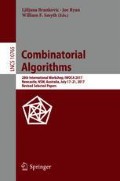Abstract
Run-length encoding Burrows-Wheeler Transformed strings, resulting in Run-Length BWT (RLBWT), is a powerful tool for processing highly repetitive strings. We propose a new algorithm for online RLBWT working in run-compressed space, which runs in \(O(n\lg r)\) time and \(O(r\lg n)\) bits of space, where n is the length of input string S received so far and r is the number of runs in the BWT of the reversed S. We improve the state-of-the-art algorithm for online RLBWT in terms of empirical construction time. Adopting the dynamic list for maintaining a total order, we can replace rank queries in a dynamic wavelet tree on a run-length compressed string by the direct comparison of labels in a dynamic list. The empirical result for various benchmarks show the efficiency of our algorithm, especially for highly repetitive strings.
Access this chapter
Tax calculation will be finalised at checkout
Purchases are for personal use only
Notes
- 1.
Or appending a character but constructing BWT for reversed string.
- 2.
- 3.
The basic idea of the algorithm originates from the work of RLFM+ index in [12].
- 4.
See http://pizzachili.dcc.uchile.cl/repcorpus/statistics.pdf for statistics of the datasets.
- 5.
- 6.
- 7.
References
DYNAMIC: Dynamic succinct/compressed data structures library. https://github.com/xxsds/DYNAMIC
Online RLBWT. https://github.com/itomomoti/OnlineRLBWT
Get-git-revisions: Get all revisions of a git repository. https://github.com/nicolaprezza/get-git-revisions
Belazzougui, D., Cunial, F., Gagie, T., Prezza, N., Raffinot, M.: Composite repetition-aware data structures. In: Cicalese, F., Porat, E., Vaccaro, U. (eds.) CPM 2015. LNCS, vol. 9133, pp. 26–39. Springer, Cham (2015). https://doi.org/10.1007/978-3-319-19929-0_3
Bender, M.A., Cole, R., Demaine, E.D., Farach-Colton, M., Zito, J.: Two simplified algorithms for maintaining order in a list. In: Möhring, R., Raman, R. (eds.) ESA 2002. LNCS, vol. 2461, pp. 152–164. Springer, Heidelberg (2002). https://doi.org/10.1007/3-540-45749-6_17
Bille, P., Cording, P.H., Gørtz, I.L., Skjoldjensen, F.R., Vildhøj, H.W., Vind, S.: Dynamic relative compression, dynamic partial sums, and substring concatenation. In: ISAAC, pp. 18:1–18:13 (2016)
Bowe, A., Onodera, T., Sadakane, K., Shibuya, T.: Succinct de Bruijn graphs. In: Raphael, B., Tang, J. (eds.) WABI 2012. LNCS, vol. 7534, pp. 225–235. Springer, Heidelberg (2012). https://doi.org/10.1007/978-3-642-33122-0_18
Burrows, M., Wheeler, D.J.: A block-sorting lossless data compression algorithm. Technical report, HP Labs (1994)
Ferragina, P., Luccio, F., Manzini, G., Muthukrishnan, S.: Structuring labeled trees for optimal succinctness, and beyond. In: FOCS, pp. 184–196 (2005)
Ferragina, P., Manzini, G.: Opportunistic data structures with applications. In: FOCS, pp. 390–398 (2000)
Hon, W., Sadakane, K., Sung, W.: Succinct data structures for searchable partial sums with optimal worst-case performance. Theor. Comput. Sci. 412(39), 5176–5186 (2011)
Mäkinen, V., Navarro, G., Sirén, J., Välimäki, N.: Storage and retrieval of highly repetitive sequence collections. J. Comput. Biol. 17(3), 281–308 (2010)
Munro, J.I., Nekrich, Y.: Compressed data structures for dynamic sequences. In: Bansal, N., Finocchi, I. (eds.) ESA 2015. LNCS, vol. 9294, pp. 891–902. Springer, Heidelberg (2015). https://doi.org/10.1007/978-3-662-48350-3_74
Navarro, G., Nekrich, Y.: Optimal dynamic sequence representations. SIAM J. Comput. 43(5), 1781–1806 (2014)
Navarro, G., Sadakane, K.: Fully functional static and dynamic succinct trees. ACM Trans. Algorithms 10(3), 16 (2014)
Policriti, A., Prezza, N.: Computing LZ77 in run-compressed space. In: DCC, pp. 23–32 (2016)
Prezza, N.: A framework of dynamic data structures for string processing. In: SEA (2017 to appear)
Sirén, J.: Compressed Full-Text Indexes for Highly Repetitive Collections. Ph.D. thesis, University of Helsinki (2012)
Sirén, J., Välimäki, N., Mäkinen, V., Navarro, G.: Run-length compressed indexes are superior for highly repetitive sequence collections. In: Amir, A., Turpin, A., Moffat, A. (eds.) SPIRE 2008. LNCS, vol. 5280, pp. 164–175. Springer, Heidelberg (2008). https://doi.org/10.1007/978-3-540-89097-3_17
Ziv, J., Lempel, A.: A universal algorithm for sequential data compression. IEEE Trans. Inf. Theory IT 23(3), 337–349 (1977)
Acknowledgments
This work was supported by JST CREST (Grant Number JPMJCR1402), and KAKENHI (Grant Numbers 17H01791 and 16K16009).
Author information
Authors and Affiliations
Corresponding author
Editor information
Editors and Affiliations
Rights and permissions
Copyright information
© 2018 Springer International Publishing AG, part of Springer Nature
About this paper
Cite this paper
Ohno, T., Takabatake, Y., I, T., Sakamoto, H. (2018). A Faster Implementation of Online Run-Length Burrows-Wheeler Transform. In: Brankovic, L., Ryan, J., Smyth, W. (eds) Combinatorial Algorithms. IWOCA 2017. Lecture Notes in Computer Science(), vol 10765. Springer, Cham. https://doi.org/10.1007/978-3-319-78825-8_33
Download citation
DOI: https://doi.org/10.1007/978-3-319-78825-8_33
Published:
Publisher Name: Springer, Cham
Print ISBN: 978-3-319-78824-1
Online ISBN: 978-3-319-78825-8
eBook Packages: Computer ScienceComputer Science (R0)

